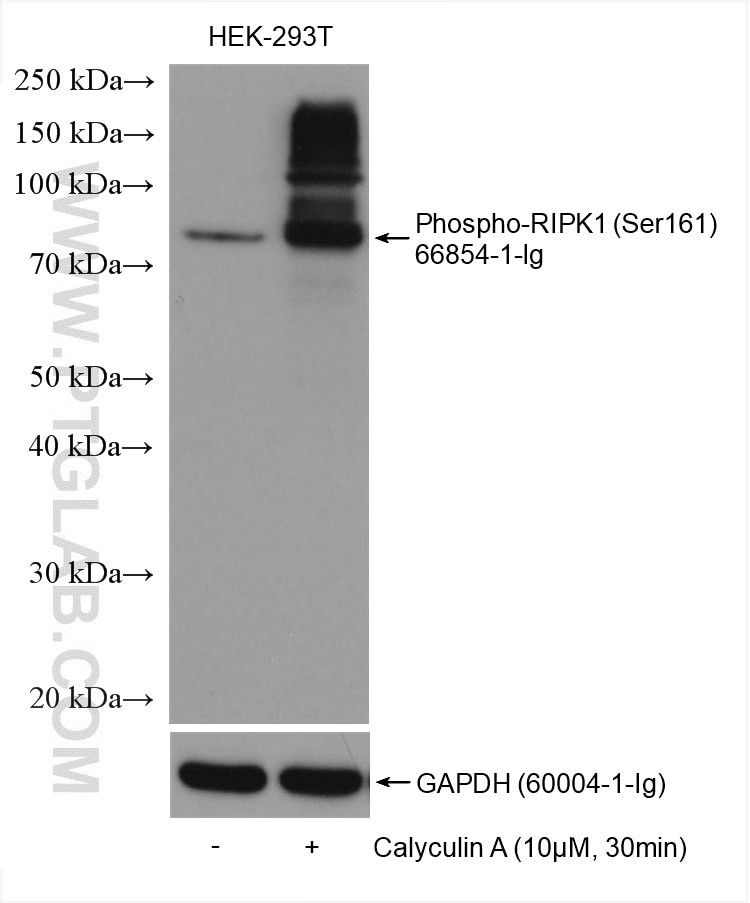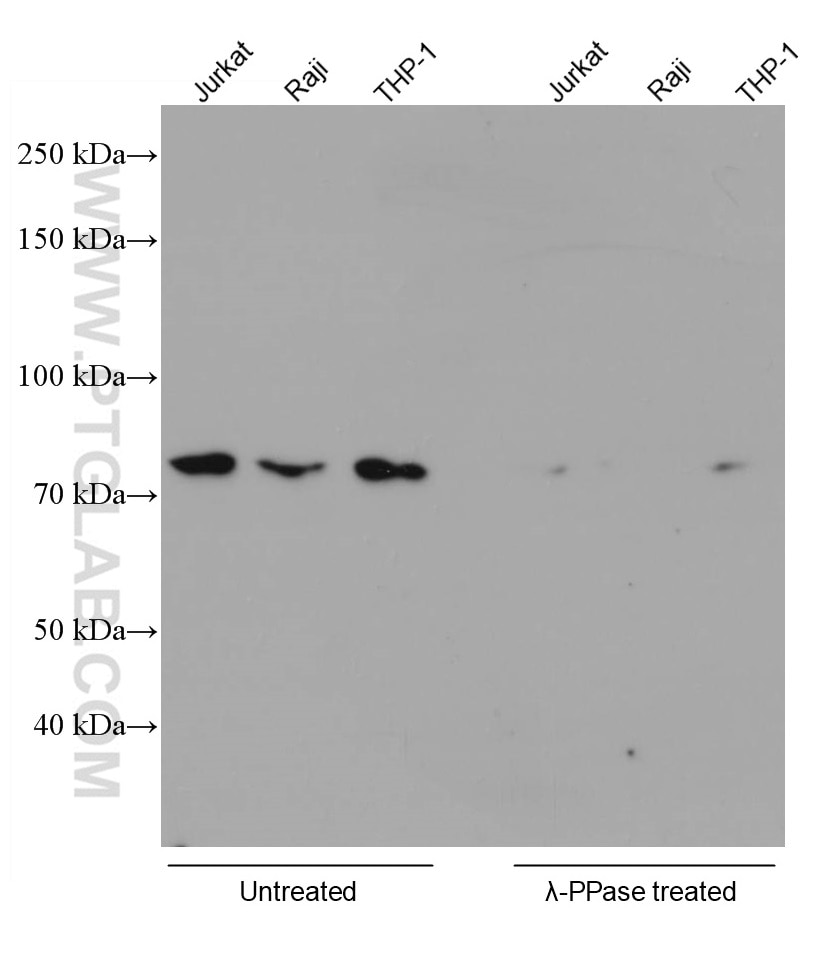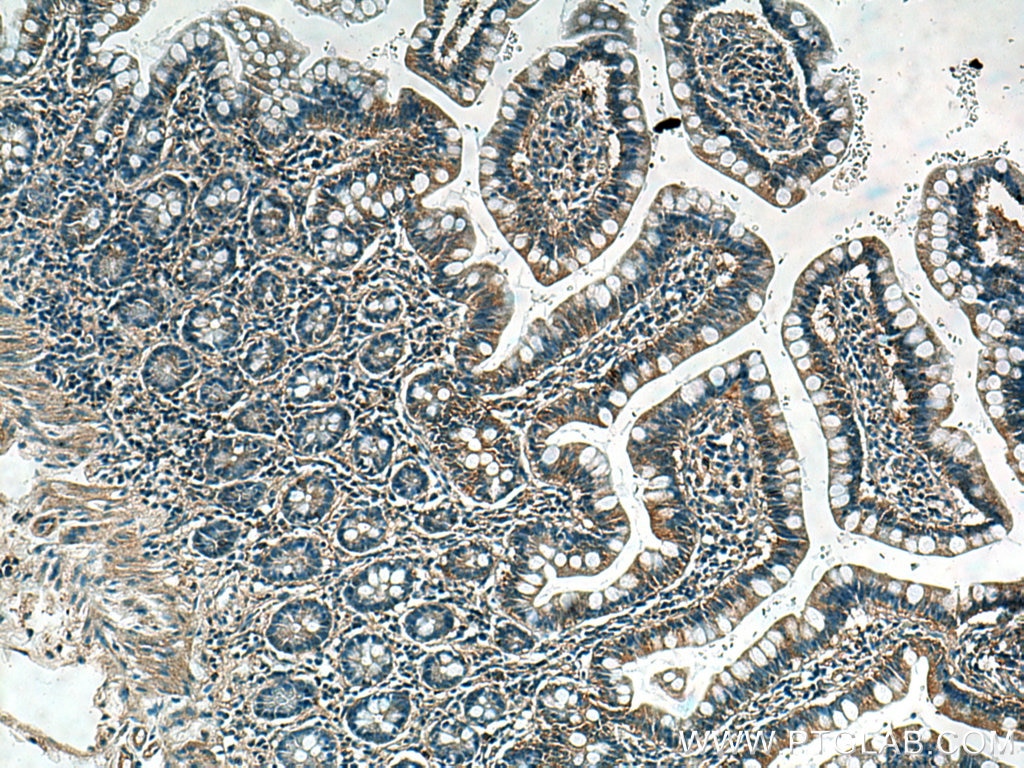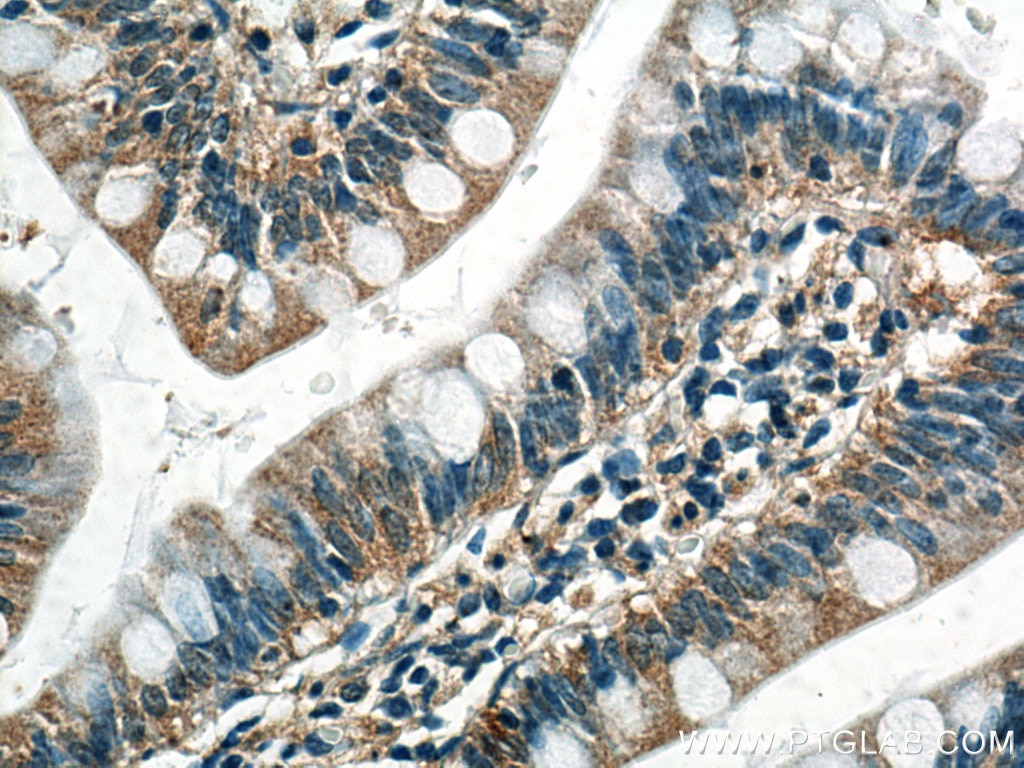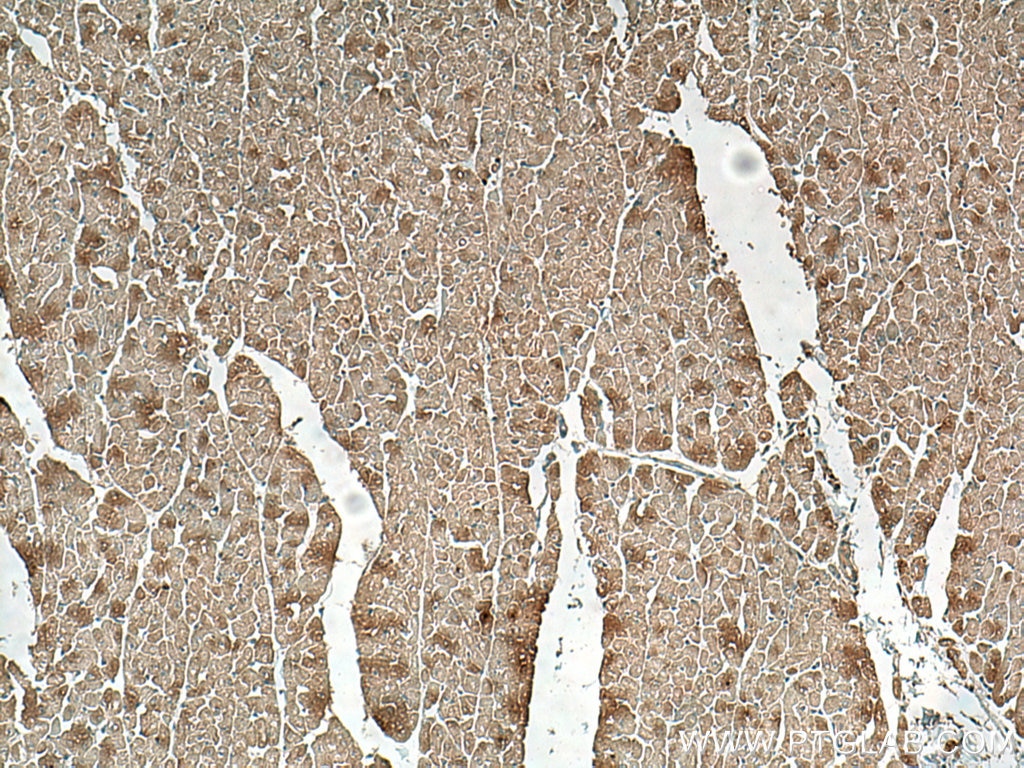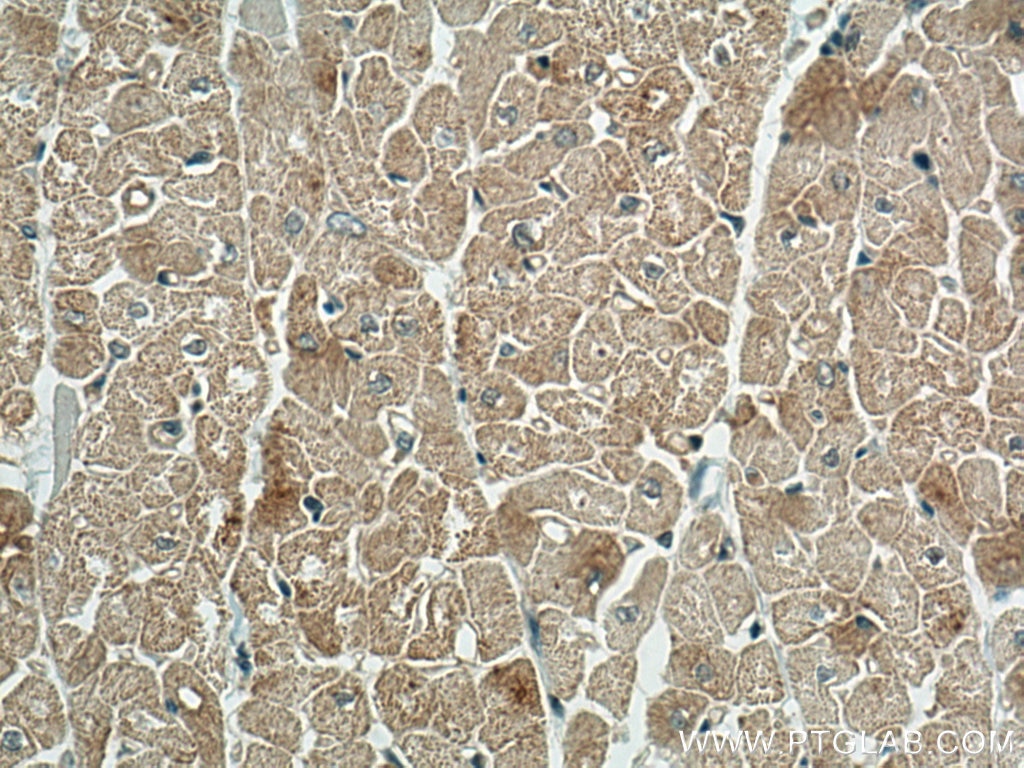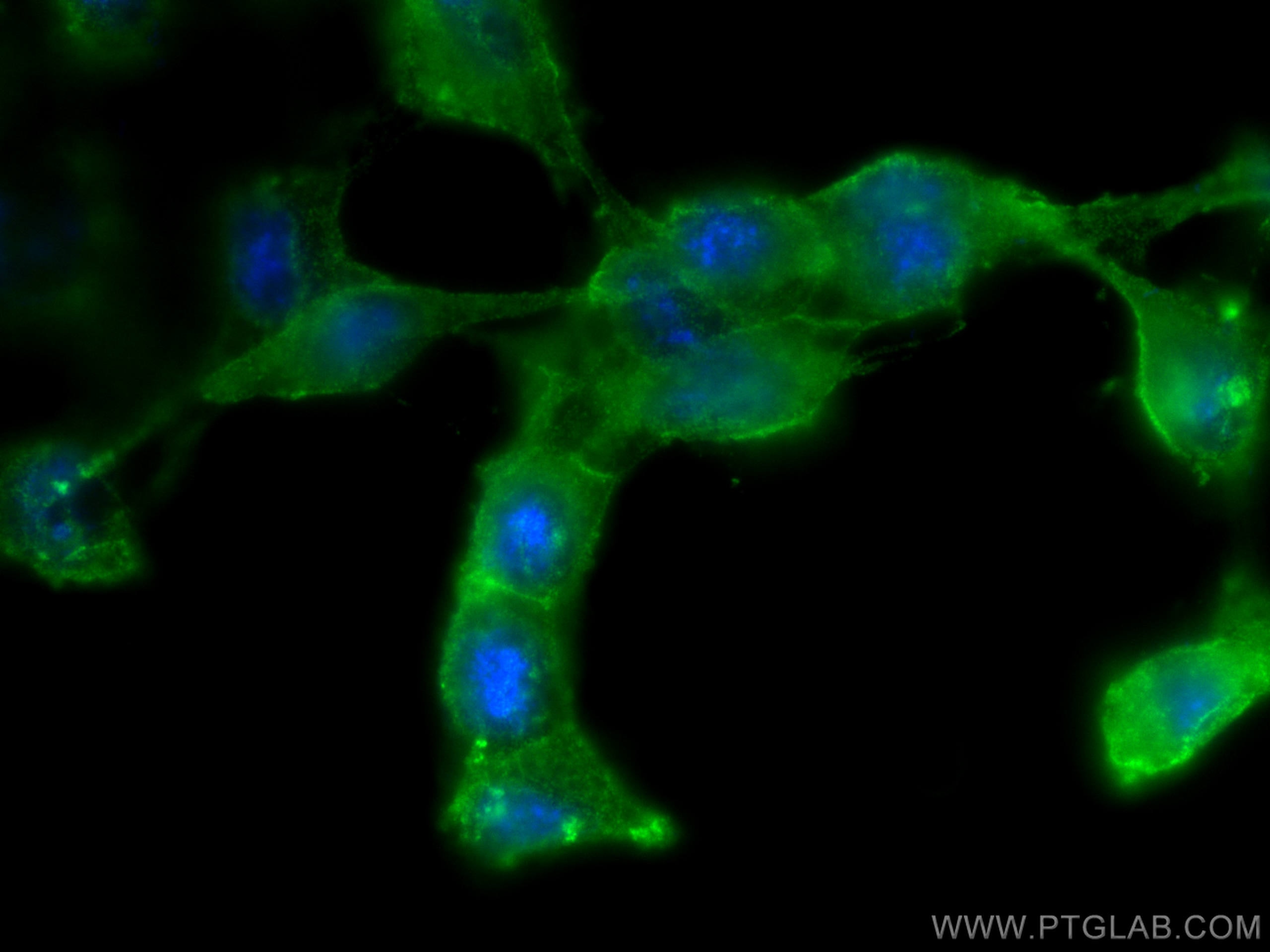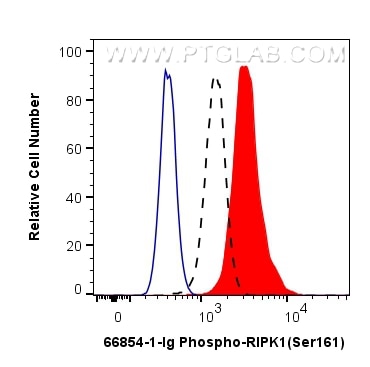Phospho-RIPK1 (Ser161) Monoklonaler Antikörper
Phospho-RIPK1 (Ser161) Monoklonal Antikörper für FC, IF, IHC, WB, ELISA
Wirt / Isotyp
Maus / IgG1
Getestete Reaktivität
human und mehr (1)
Anwendung
WB, IHC, IF, FC, ELISA
Konjugation
Unkonjugiert
CloneNo.
1B2G1
Kat-Nr. : 66854-1-Ig
Synonyme
Galerie der Validierungsdaten
Geprüfte Anwendungen
| Erfolgreiche Detektion in WB | Jurkat-Zellen, mit Calyculin A behandelte HEK-293T-Zellen, Raji-Zellen, THP-1-Zellen |
| Erfolgreiche Detektion in IHC | humanes Dünndarmgewebe, humanes Herzgewebe Hinweis: Antigendemaskierung mit TE-Puffer pH 9,0 empfohlen. (*) Wahlweise kann die Antigendemaskierung auch mit Citratpuffer pH 6,0 erfolgen. |
| Erfolgreiche Detektion in IF | U2OS-Zellen |
| Erfolgreiche Detektion in FC | mit Calyculin A behandelte HEK-293T-Zellen |
Empfohlene Verdünnung
| Anwendung | Verdünnung |
|---|---|
| Western Blot (WB) | WB : 1:2000- 1:20000 |
| Immunhistochemie (IHC) | IHC : 1:250-1:1000 |
| Immunfluoreszenz (IF) | IF : 1:200-1:800 |
| Durchflusszytometrie (FC) | FC : 0.13 ug per 10^6 cells in a 100 µl suspension |
| It is recommended that this reagent should be titrated in each testing system to obtain optimal results. | |
| Sample-dependent, check data in validation data gallery | |
Veröffentlichte Anwendungen
| WB | See 8 publications below |
| IHC | See 1 publications below |
Produktinformation
66854-1-Ig bindet in WB, IHC, IF, FC, ELISA Phospho-RIPK1 (Ser161) und zeigt Reaktivität mit human
| Getestete Reaktivität | human |
| In Publikationen genannte Reaktivität | human, Maus |
| Wirt / Isotyp | Maus / IgG1 |
| Klonalität | Monoklonal |
| Typ | Antikörper |
| Immunogen | Peptid |
| Vollständiger Name | receptor (TNFRSF)-interacting serine-threonine kinase 1 |
| Berechnetes Molekulargewicht | 76 kDa |
| Beobachtetes Molekulargewicht | 74 kDa, 45 kDa |
| GenBank-Zugangsnummer | NM_003804 |
| Gene symbol | RIPK1 |
| Gene ID (NCBI) | 8737 |
| Konjugation | Unkonjugiert |
| Form | Liquid |
| Reinigungsmethode | Protein-A-Reinigung |
| Lagerungspuffer | PBS mit 0.02% Natriumazid und 50% Glycerin pH 7.3. |
| Lagerungsbedingungen | Bei -20°C lagern. Nach dem Versand ein Jahr lang stabil Aliquotieren ist bei -20oC Lagerung nicht notwendig. 20ul Größen enthalten 0,1% BSA. |
Hintergrundinformationen
RIPK1(Receptor-interacting serine/threonine-protein kinase 1) is primarily involved in mediating TNF-R1-induced cell activation, apoptosis and necroptosis and belongs to a novel class of kinases thatfunction in cell survival and cell death mechanisms(PMID:22685397 ).It has 2 isoforms produced by alternative splicing.It also can exist as the protein with lower molecular weight about 25kd and 45kd in HAEC and HUVEC(PMID:22685397).
Protokolle
| Produktspezifische Protokolle | |
|---|---|
| WB protocol for Phospho-RIPK1 (Ser161) antibody 66854-1-Ig | Protokoll herunterladen |
| IHC protocol for Phospho-RIPK1 (Ser161) antibody 66854-1-Ig | Protokoll herunterladen |
| IF protocol for Phospho-RIPK1 (Ser161) antibody 66854-1-Ig | Protokoll herunterladen |
| Standard-Protokolle | |
|---|---|
| Klicken Sie hier, um unsere Standardprotokolle anzuzeigen |
Publikationen
| Species | Application | Title |
|---|---|---|
Inflammation Ursolic Acid Promotes Autophagy by Inhibiting Akt/mTOR and TNF-α/TNFR1 Signaling Pathways to Alleviate Pyroptosis and Necroptosis in Mycobacterium tuberculosis-Infected Macrophages | ||
J Cell Mol Med LRG-1 promotes fat graft survival through the RAB31-mediated inhibition of hypoxia-induced apoptosis. | ||
Front Genet Exosome-Derived LncRNA TCONS_00072128 Mediated Osteogenic Differentiation and Inflammation by Caspase 8 Regulation. | ||
Am J Physiol Renal Physiol Myo-inositol oxygenase overexpression exacerbates cadmium-induced kidney injury via oxidant stress and necroptosis. | ||
Eur J Pharmacol A natural chalcone cardamonin inhibits necroptosis and ameliorates dextran sulfate sodium (DSS)-induced colitis by targeting RIPK1/3 kinases | ||
Front Oncol Identification of necroptosis-related genes for predicting prognosis and exploring immune infiltration landscape in colon adenocarcinoma |
